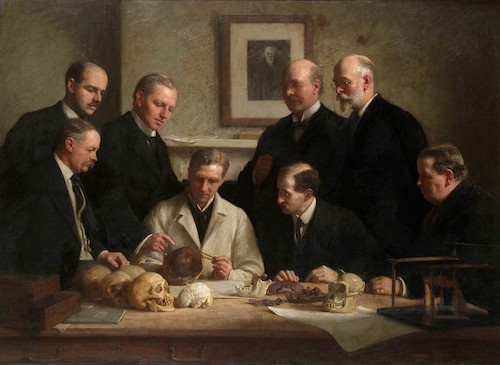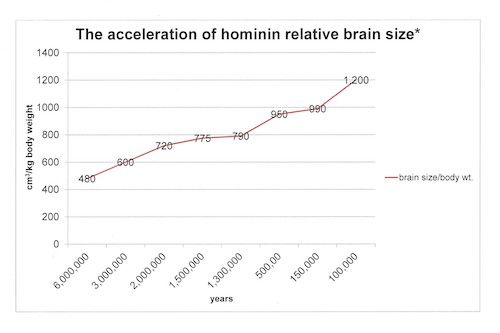 Evolution
Evolution
What the Piltdown Hoax Tells Us, 104 Years Later

A curious anniversary falls this weekend. On December 18, 1912, the infamous Piltdown hoax was unveiled to an astonished audience of the Geological Society of London by lawyer and amateur archeologist Charles Dawson (1864-1916) and Arthur Smith Woodward (1864-1944) of the British Museum. What they showed was nothing short of amazing: the apparent remains of a human-like skull attached to an ape-like jaw. Allegedly unearthed at the Piltdown gravel pit in East Sussex, England, it was hailed as the missing link — a truly history-making discovery!
It would take nearly 41 years to expose the artifact as a fraud. On November 21, 1953, officials of the British Natural History Museum revealed the shocking truth: Piltdown man was a hoax, the combination of three species, a medieval human cranium, the jaw of a centuries-old young orangutan, and some fossilized chimpanzee teeth. Various culprits have been proposed, including famed Jesuit philosopher Teilhard de Chardin (1881-1955) and physician/novelist Sir Arthur Conan Doyle (1859-1930). But most recent investigation suggests that the imposture was likely perpetrated by Dawson alone in an effort to gain recognition and election as a Fellow into the Royal Society (see “Piltdown hoax solved,” Forbes, August 10, 2016).
Writing for Harper’s on the second anniversary of the Piltdown exposure, paleontologist Loren Eiseley (1907-1977), not one to look at an event or a phenomenon superficially, asked, “Was Charles Darwin Wrong About the Human Brain?” Eiseley noted that Alfred Russel Wallace (1823-1913), co-discoverer of the theory of natural selection, was unimpressed with the Piltdown “find” from the beginning. Writing to a friend in August 1913 (just three months before his death), Wallace exclaimed, “The Piltdown skull does not prove much, if anything!” Why, asked Eiseley, had Wallace, almost alone among the scientific community, so summarily dismissed this apparently stunning missing link? The answer was simple: “he did not believe in a skull which had a modern brain box attached to an apparently primitive face and given, in the original estimates, an antiquity of something over a million years.” The archeological “discovery” would have confirmed Darwin’s Descent of Man in dramatic fashion. Indeed Piltdown man was, from a Darwinian perspective, even something that would have been predicted.
But Wallace’s “voice of lonely protest,” observed Eiseley, underscored “the abyss which yawned between man and ape” that Darwinians at the time blissfully ignored. Having observed primitive cultures in South America and the Malay Archipelago for more than twelve years, Wallace concluded (quoting Eiseley) that humans’ “mental powers were far in excess of what they really needed to carry on the simple food-gathering techniques by which they survived.” Certainly no process of natural selection was adequate to produce such superior powers of art, reason, and morals. For Wallace, the human brain freed mankind from the tyranny of natural selection:
Here, then, we see the true grandeur and dignity of man. On this view of his special attributes, we may admit, that even those who claim for him a position as an order, or a sub-kingdom by himself, have some show of reason on their side. He is, indeed, a being apart, since he is not influenced by the great laws which irrestistibly modify all other organic beings (Contributions to the Theory of Natural Selection, 1870).
How, then, do we account for this impressive array of human attributes? Wallace thought that mankind might well have emerged comparatively recently, and that the rapid evolution of the modern human brain would confirm that “distinct and higher agencies” have been responsible for these mental attributes and attainments.
Eiseley confessed, “Since the exposure of the Piltdown hoax all of the evidence at our command — and it is considerable — points to man, in his present form, as being one of the youngest and newest of all earth’s swarming inhabitants. . . . Today, with the solution of the Piltdown enigma, we must settle the question of the time involved in favor of Wallace, not Darwin.” Although Eiseley thought some other wholly naturalistic explanation might account for the late and virtually saltationist expansion of the human intellect, he confessed that “science . . . has yet to explain how we have come so far so fast, nor has it any completely satisfactory answer to the question asked by Wallace long ago.”
Today we still wait for an explanation, and it must be admitted that various speculations along the lines of blind chance and necessity or natural selection remain as unsatisfactory as when Eiseley was writing more than sixty years ago. A century after Wallace’s dismissal of Piltdown man, science still confirms Eiseley’s assessment and Wallace’s vindication. The chart below shows the timeline for ascending brain size/body weight estimates for Sahelanthropus, Australopithecus afarensis, early Homo, Homo habilis, Homo erectus, H. heidelbergensis, Neanderthals, and H. sapiens.

This chart shows relative brain size as cm3 per 50 kg of body weight. Adapted with modifications from Robert Jurmain, Lynn Kilgore, et al., Introduction to Physical Anthropology, 2013-2014 ed. (Wadsworth, Cengage Learning, 2014), p. 357, and “Homo habilis,” Encyclopedia Britannica, updated August 15, 2015.
Clearly brain size and capacity has not only increased, but increased at a very late and remarkably accelerated pace. Of course brain size is not the only measure of intellectual capacity, other factors may be involved. Some, for example, emphasize that Neanderthals, the closest historically to humans, possessed brains that were larger in absolute size to us. But as recent analysis has uncovered, the Neanderthal brain was quite different from its human counterpart. Being much more elongated than globular, the indications are that Neanderthals “reached large brain sizes along different evolutionary pathways.” Their speculation that unique patterns of brain development in H. sapiens would have become “a target for positive selection” merely begs Wallace’s original question (see Gunz et al., “Brain development after birth differs between Neanderthals and modern humans,” Current Biology, Nov. 2010).
So the question remains: How did humans acquire such vast intellectual capacities so comparatively recently and so rapidly? Wallace called upon an “Overruling Intelligence” to explain human intelligence and many other features of complexity in biology and the cosmos. While Darwinians continue to search for some naturalistic cause, others, like British physician James Le Fanu, point out that the disappointments in high-tech solutions to the nature of the intellect and the human mind so touted by the human genome project and promised in the “Decade of the Brain” in the 1990s should force a reassessment of our species as truly unique (Why Us?: How Science Rediscovered the Mystery of Ourselves, 2009).
Eiseley’s long forgotten but intriguing article is fortunately now available as “The Real Secret of Piltdown” in a new 2-volume set of his collected essays. As we reflect on the 104th anniversary of arguably science’s greatest fraud, Eiseley’s conclusion rings is as pertinent today as when it was first written:
The true secret of Piltdown, though thought by the public to be merely the revelation of an unscrupulous forgery, lies in the fact that it has forced science to reexamine carefully the history of the most remarkable creation in the world — the human brain.
If the Cambrian period of 530 million years ago poses serious challenges to Darwin’s insistence upon slow, incremental change in the amazingly rapid proliferation of animals over a mere 5 to 6 million-year timespan (see Darwin’s Doubt), then how much more should the transformational changes in the human brain over the past 100 to 200,000 years cause as serious reevaluation of the nature of human beings and the means by which they came to be. If the Cambrian “explosion” is just too much change over too little time to be explained by Darwinian processes, the human brain is way too much change over way too little time. Perhaps Wallace’s view of the Piltdown hoax still holds an important lesson for us today. Maybe the most dramatic “explosion” of all is the one that rests within our crania.
Image: Studying the Piltdown skull, by John Cooke [Public domain], via Wikimedia Commons.
